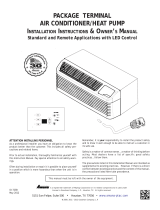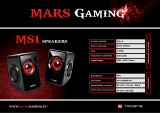
17
DIAGNOSTIC CODES
C1
Indoor Coil is freezing up. N Y
Clean filter, Check for fan and blower operation,
Check for Refrigerant loss
or Restricted capillary tube.
C3
Indoor Coil is freezing up. N Y
Clean filter, Check for fan and blower operation,
Check for Refrigerant loss
or Restricted capillary tube.
C4
Indoor Coil froze up. N Y
Clean filter, Check for fan and blower operation,
Check for Refrigerant loss
or Restricted capillary tube.
C6
Poor Unit Performance. N Y
Check for blower motor, compressor,
or electric heat operation.
C7 Indoor Freezing Lockout (ICT - IAT > 20) +10 Min N Y
Clean filter, Check for fan and blower operation,
Check for Refrigerant loss
or Restricted capillary tube.
REFRIGERATION
ALERTS
STATUS DISPLAY
ERROR
LIGHT
SUGGESTED ACTION
FP
Freeze
Protection
Engaged. The room temperature
measured by the wireless remote thermostat or indoor ambient
thermistor active sensor falls below 40°F.
YN
No Action required. This setting will disengage when the
room temperature rises above 43°F.
Fd
Front
Desk
switch is closed. All outputs are switched off. Y N Open front desk switch to allow occupant unit operation.
Eo
Un-Configured Service Board -
All operation held awaiting configuration
YY
Enter Configuration Menu and set "C3" to "C"
for coolers with electric heat or "H" for heat pumps.
EH
Emergency Hydronic
Engaged. The EHH switch is closed.
Compressor is switched off.
YN
Open front emergency hydronic switch to allow occupant
unit operation.
LS
Load Shedding
Engaged. The LS switch is closed.
Compressor and Electric heat is switched off.
YN
Open load shedding switch
to allow occupant unit operation.
On
Control is configured to respond to a wired thermostat Y N
No action if a wired thermostat is being used.
Otherwise, see Configuration Settings.
oP
Open Door Lockout
(DS1 & DS2 open; wireless)
YY
Close Room Door.
Unit will not condition space with door open.
nP
Window Switch Lockout -
(LS & INN open)
YY
Close Room Door or Window.
Unit will not condition space with door or window open.
hP
Heat Sentinel -
(WIAT > u3)
YN
No action required. This setting will disengage when
the room temperature falls.
Ur
Un-Rented Status
(EHH & INN or wireless)
Y N Front Desk needs to set to Rented mode (if applicable).
Indoor Ambient Thermistor reads outside the
range -20°F to 200°F
&
the wireless thermostat is not
communicating to the unit control or
Indoor Ambient Thermistor (IAT) without a wireless remote
thermostat reads outside the range -20°F to 200°F.
F2
Wireless Remote Thermostat failure N N Replace Wireless Thermostat.
F3
Indoor Ambient Thermistor reads
outside the range -20°F to 200°F
Y N Replace black Indoor Ambient Thermistor.
F4
Indoor Coil Thermistor either above
or below operating tolerances.
N Y Replace Red Indoor Coil Thermistor .
F5
Wireless Thermostat failure. N Y
Attempt to rebind Wireless Thermostat
or Replace Wireless Thermostat.
F6
Indoor Discharge Thermistor either above
or below operating tolerances.
NY
Replace Yellow Indoor
Discharge Thermistor.
Fb Low Remote Battery Warning. N Y Replace Batteries in Wireless Devices.
H1
High Voltage Protection engaged.
Power supply voltage is to high.
Y N Check for incoming power at correct voltage.
br
Brown Out Protection engaged.
Power was lost or voltage is low.
N N Check for incoming power at correct voltage.
L6
Discharge Air Too Hot. N Y Clean Filter or Remove Air Blockage.
LC
Outdoor Coil Thermistor temperature high. N Y
Clean Condenser Coils, Check Fan for
fault. Code will reset after cleaning.
C2
Indoor Air Recirculation. Large delta between thermostat and
return.
NY
Clean Filter or Remove Air Blockage or Close
Vent Door or Improve indoor to outdoor seal.
C5
Outdoor Coil temperature too high for outdoor ambient
temperature.
N Y Check for Blocked Outdoor Air or Clean Coil.
Replace black Indoor Ambient Thermistor or
Wireless Remote Thermostat.
YY
F1
CODE
AIRFLOW
ALERTS
FAILURES MODES
























